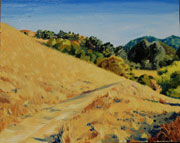
 I took advantage of the mild October weather (read: not rainy) to do a couple of quick oils in the park behind our house. Finding a cow-free spot requires a mile-long trek uphill through hot dusty fireroads. I normally take a $30. aluminum portable easel, a hat, a snack, a bottle of water, my sunglasses, a long sleeved shirt, and a foldable chair that doubles as backpack. Inside are no more than six tubes of basic colors, a pad of disposable palette paper, some turpentine, a set of about 20 hog brushes, a bit of stand oil, and some rags. Sometimes I bring a pencil, but most of the time I forget.
I took advantage of the mild October weather (read: not rainy) to do a couple of quick oils in the park behind our house. Finding a cow-free spot requires a mile-long trek uphill through hot dusty fireroads. I normally take a $30. aluminum portable easel, a hat, a snack, a bottle of water, my sunglasses, a long sleeved shirt, and a foldable chair that doubles as backpack. Inside are no more than six tubes of basic colors, a pad of disposable palette paper, some turpentine, a set of about 20 hog brushes, a bit of stand oil, and some rags. Sometimes I bring a pencil, but most of the time I forget.
It takes me anywhere from one to two hours to complete a 16" by 20" canvas, if it's not too windy. I try to find a shady spot, but if I do, I end up wearing a jacket. All that sitting makes you lose your body heat eventually. As with watercolors, size makes a big difference in your execution. A smaller canvas means you can spend more time on details you'd have to ignore otherwise. The smaller your painting surface, the more thought you can give to what you're painting.
What do I think about? I periodically survey the whole picture from a distance. If I cannot get up to look at it from four to five feet, I half-close my eyes to obliterate seductive but ultimately periferal details. I also keep a running list of what I need to correct. Some corrections I leave for home, and some need to be immediate. At times I stop and just look very carefully. Later, I might use that memory to modify an element in the picture. In short, plein air painting is about constant revision, or revision-on-the-go.
No comments:
Post a Comment